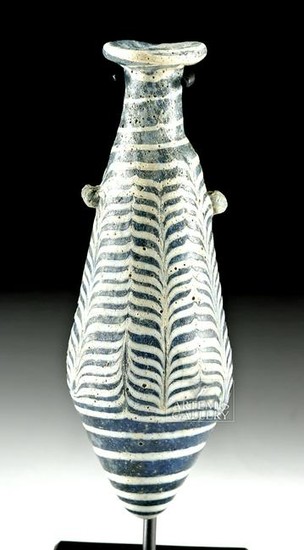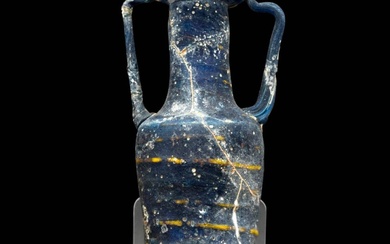Greek Hellenistic Core Formed Glass Alabastron
**Originally Listed At $1600**
Greece, Hellenistic, ca. 2nd to 1st century BCE. An elegant core-formed alabastron comprised of deep midnight blue glass with opaque white trailing and a pair of applied lug handles of blue glass. The mesmerizing pattern featured throughout the entire vessel is the result of an opaque white trail wound around the rim of the disk-shaped mouth down the neck and shoulder, then down the body length where it is combed into an attractive feathered pattern, and finally wound around the lower section in a continuous spiraled band to the rounded bottom. Size: 4.375" H (11.1 cm); 5.125" H (13 cm) on included custom stand.
The alabastron is a long-bodied vessel with a rounded bottom, a cylindrical or teardrop shaped body, and a flat disk mouth. Though usually without handles, some alabastra have eyes or lugs, like this example. According to the Beazley Archive of the University of Oxford, the alabastron shape's history extends back to Corinth, but was only preserved in Athenian pottery examples back to the mid-sixth century BCE. Alabastra were created in many materials, including alabaster, and the Greek term for this stone - alabastron (most likely of Egyptian origin) - was the source of inspiration for the name of this shaped vessel. Many examples were finished with a white ground, as if to imitate this stone. We know from vase painting imagery of women using alabastra following a bath, that these vessels most likely held perfumed oils.
According to the Corning Museum of Glass, core forming is "the technique of forming a vessel by winding or gathering molten glass around a core supported by a rod. After forming, the object is removed from the rod and annealed. After annealing, the core is removed by scraping." This process of glass making was begun in the late 16th century BCE by glassmakers of Mesopotamia, and then adopted by Egyptian glassmakers in the 15th century BCE. The technique almost came to an end in the so-called Dark Ages of Mediterranean civilization (1200 to 900 BCE); however, by the 9th century BCE a new generation of glassmakers took up the technique once again, and between the 6th and 4th century BCE core-forming spread throughout the Mediterranean.
For a stylistically-similar example, please see "Reflections of the Past: A Selection of Objects from the Ancient World." Fortuna Fine Arts, Ltd., New York, 2001, fig. 24.
Provenance: private East Coast, USA collection; ex-Mario & Anita Zuerrer collection, Zurich, Switzerland, acquired in the 1980s
All items legal to buy/sell under U.S. Statute covering cultural patrimony Code 2600, CHAPTER 14, and are guaranteed to be as described or your money back.
A Certificate of Authenticity will accompany all winning bids.
We ship worldwide to most countries and handle all shipping in-house for your convenience.
#143944
Condition Report: Some normal weathering to surface commensurate with age. Some nicks and encrustation to handles. Otherwise excellent.
View it on
Estimate
Time, Location
Auction House
**Originally Listed At $1600**
Greece, Hellenistic, ca. 2nd to 1st century BCE. An elegant core-formed alabastron comprised of deep midnight blue glass with opaque white trailing and a pair of applied lug handles of blue glass. The mesmerizing pattern featured throughout the entire vessel is the result of an opaque white trail wound around the rim of the disk-shaped mouth down the neck and shoulder, then down the body length where it is combed into an attractive feathered pattern, and finally wound around the lower section in a continuous spiraled band to the rounded bottom. Size: 4.375" H (11.1 cm); 5.125" H (13 cm) on included custom stand.
The alabastron is a long-bodied vessel with a rounded bottom, a cylindrical or teardrop shaped body, and a flat disk mouth. Though usually without handles, some alabastra have eyes or lugs, like this example. According to the Beazley Archive of the University of Oxford, the alabastron shape's history extends back to Corinth, but was only preserved in Athenian pottery examples back to the mid-sixth century BCE. Alabastra were created in many materials, including alabaster, and the Greek term for this stone - alabastron (most likely of Egyptian origin) - was the source of inspiration for the name of this shaped vessel. Many examples were finished with a white ground, as if to imitate this stone. We know from vase painting imagery of women using alabastra following a bath, that these vessels most likely held perfumed oils.
According to the Corning Museum of Glass, core forming is "the technique of forming a vessel by winding or gathering molten glass around a core supported by a rod. After forming, the object is removed from the rod and annealed. After annealing, the core is removed by scraping." This process of glass making was begun in the late 16th century BCE by glassmakers of Mesopotamia, and then adopted by Egyptian glassmakers in the 15th century BCE. The technique almost came to an end in the so-called Dark Ages of Mediterranean civilization (1200 to 900 BCE); however, by the 9th century BCE a new generation of glassmakers took up the technique once again, and between the 6th and 4th century BCE core-forming spread throughout the Mediterranean.
For a stylistically-similar example, please see "Reflections of the Past: A Selection of Objects from the Ancient World." Fortuna Fine Arts, Ltd., New York, 2001, fig. 24.
Provenance: private East Coast, USA collection; ex-Mario & Anita Zuerrer collection, Zurich, Switzerland, acquired in the 1980s
All items legal to buy/sell under U.S. Statute covering cultural patrimony Code 2600, CHAPTER 14, and are guaranteed to be as described or your money back.
A Certificate of Authenticity will accompany all winning bids.
We ship worldwide to most countries and handle all shipping in-house for your convenience.
#143944
Condition Report: Some normal weathering to surface commensurate with age. Some nicks and encrustation to handles. Otherwise excellent.




